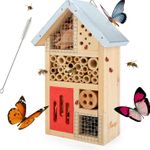
Despite gardeners’ best efforts, deer do damage landscape plantings. The two questions most frequently asked are: “What can I plant that deer won’t eat?” and “How can I stop deer from browsing on my favorite plants?” Well, if I had the answers, I’d probably become something of a horticultural legend. The simple answers are that there are very few truly deer-proof plants and that, if deer are hungry enough, repellents, scare devices and gadgets, and poorly constructed physical barriers will all fail. Over the years, however, I have developed a repellent program that helps in the fight against deer. With a little diligence and a mix of strategies, you can achieve a “more-than-just-bare-stems” look in your landscape.
Early spring
Hang sachets filled with Milorganite fertilizer around the area, or apply Milorganite (at half the recommended rate) around emerging bulbs and spring ephemerals. Reapply a month later. Applications of liquid foliar fertilizers/repellents, such as Bobbex, work equally well; just don’t apply them in late summer or fall.
Late spring/summer
Apply spray repellents like I Must Garden Deer Repellent, an odor-based repellent, every two to four weeks once plants have fully leafed out. Spritz flower buds as they appear with an egg-based product like Deer-Off. Deer-Stopper is a good alternative, or you can make your own repellent. Mix and spray the following ingredients every 10 days: 1 egg, 1/2 cup of whole milk, 1 tablespoon of cooking oil, 1 tablespoon of liquid soap, and 1 gallon of water.
Late summer/fall
Continue your summer program. Evaluate environmental and biological factors (like the abundance of food sources or the increase in deer numbers) to determine if you should rely on repellents or physical barriers, like fencing or burlap wraps, for the winter months.
Winter
Apply a blood-derived spray repellent like Plantskydd during the dormant season (once in November and again in January). Odor- or taste-based repellents can be less effective during cold temperatures. Repellents containing thiram, like Bonide Deer and Rabbit Repellent, will also work; just be sure to add an adhesive like Vapor Gard, because thiram does not withstand weather well.
More ways to have a deer-proof garden
Fine Gardening Recommended Products

Pruning Simplified: A Step-by-Step Guide to 50 Popular Trees and Shrubs
Fine Gardening receives a commission for items purchased through links on this site, including Amazon Associates and other affiliate advertising programs.

A.M. Leonard Deluxe Soil Knife & Leather Sheath Combo
Fine Gardening receives a commission for items purchased through links on this site, including Amazon Associates and other affiliate advertising programs.

Niteangel Natural Wooden Insect Hotel, Garden Insect House for Ladybugs, lacewings, Butterfly, Bee, Bug
Fine Gardening receives a commission for items purchased through links on this site, including Amazon Associates and other affiliate advertising programs.


















Comments
Why should you not apply repellents such as Bobbex in the late summer or fall?
I have been using chicken wire.....laid out between garden rows. I maintain the tactile feel of the wire on deer hooves discourages them from crossing into the garden. Obviously, this effort requires some extra effort, ie, moving the wire when tilling and diligent weeding to avoid weeds growing through eventually inhibiting wire removal at end of growing season, but IT WORKS. I've not had deer-in-the-garden problems for the four years I've been using this method. Prior to this I was losing my entire crop of green beans, sweet peppers, and okra. Also, original investment is pricey but the wire lasts for years (I'm still using my original purchase), and over the years may prove cheaper than other annual purchases of not-so-good repellents.
Log in or create an account to post a comment.
Sign up Log in